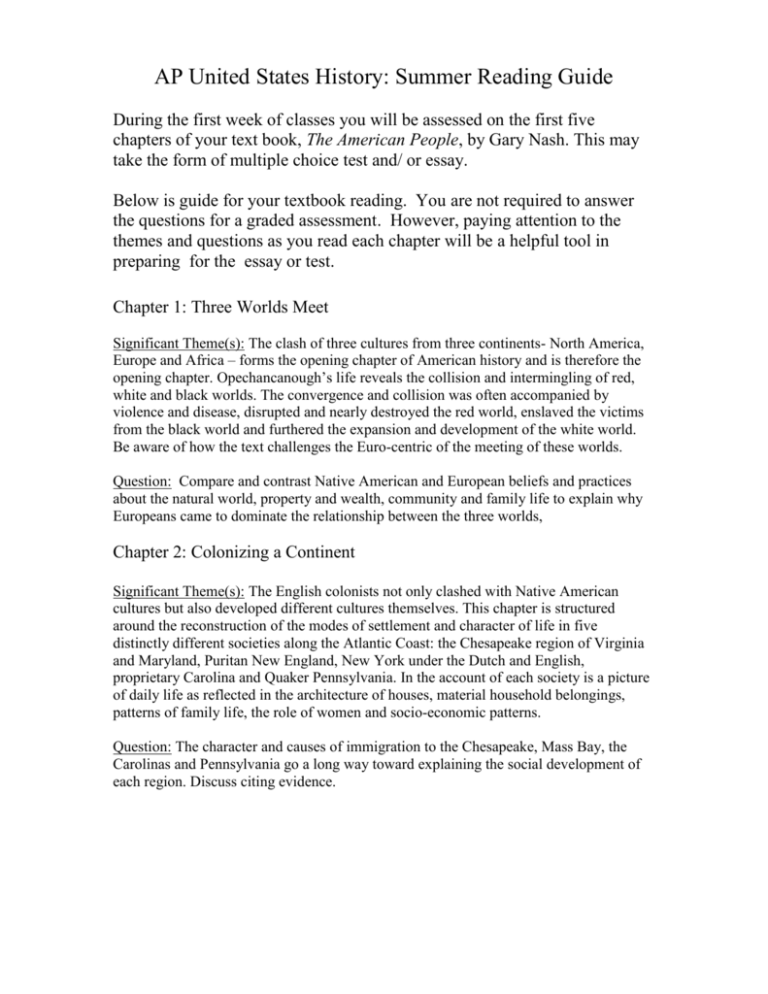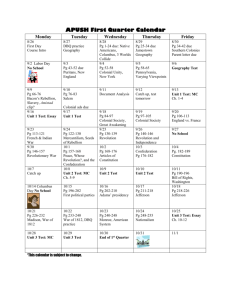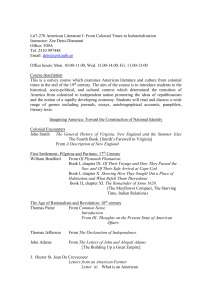AP United States History: Summer Reading Guide
advertisement

AP United States History: Summer Reading Guide During the first week of classes you will be assessed on the first five chapters of your text book, The American People, by Gary Nash. This may take the form of multiple choice test and/ or essay. Below is guide for your textbook reading. You are not required to answer the questions for a graded assessment. However, paying attention to the themes and questions as you read each chapter will be a helpful tool in preparing for the essay or test. Chapter 1: Three Worlds Meet Significant Theme(s): The clash of three cultures from three continents- North America, Europe and Africa – forms the opening chapter of American history and is therefore the opening chapter. Opechancanough’s life reveals the collision and intermingling of red, white and black worlds. The convergence and collision was often accompanied by violence and disease, disrupted and nearly destroyed the red world, enslaved the victims from the black world and furthered the expansion and development of the white world. Be aware of how the text challenges the Euro-centric of the meeting of these worlds. Question: Compare and contrast Native American and European beliefs and practices about the natural world, property and wealth, community and family life to explain why Europeans came to dominate the relationship between the three worlds, Chapter 2: Colonizing a Continent Significant Theme(s): The English colonists not only clashed with Native American cultures but also developed different cultures themselves. This chapter is structured around the reconstruction of the modes of settlement and character of life in five distinctly different societies along the Atlantic Coast: the Chesapeake region of Virginia and Maryland, Puritan New England, New York under the Dutch and English, proprietary Carolina and Quaker Pennsylvania. In the account of each society is a picture of daily life as reflected in the architecture of houses, material household belongings, patterns of family life, the role of women and socio-economic patterns. Question: The character and causes of immigration to the Chesapeake, Mass Bay, the Carolinas and Pennsylvania go a long way toward explaining the social development of each region. Discuss citing evidence. Chapter 3: Mastering the New World Significant Theme(s): 1.This chapter treats five conflicts in the colonial period between 1675 and 1715; two dealt with the European colonial efforts to establish mastery over African slaves and Native American Indians; two concerned administrative and class struggles among the English colonists themselves; the final one was an international struggle as the British sought mastery over French, Dutch and Spanish colonial contenders. 2. Although the boundaries of American slavery were at first fluid, the institution of slavery altered the shape of American society. Slavery became a primary source of labor and profits in the Chesapeake region but was also closely bound up with economic life in the North. Slavery profoundly affected the lives of both white and black Americans and was an ironic comment on the dream of America as a land of refuge and hope. Question: Select two intra-colonial conflicts within the English colonies. Explain the sources of the conflict, how they manifested themselves and the outcome of the conflict. Chapter 4: The Maturing of Colonial Society Significant Theme(s): 1. The farming society of the North was characterized by widespread land ownership and a rough kind of economic equality. In the South, plantation society was marked by the emergence of a gentry class and a labor force almost entirely made up of black slaves, while the backcountry, still in frontier stages and settled by thousands of Scots-Irish and German immigrants, lacked the sharp class distinctions of the tidewater region. Colonial cities, with their highly differentiated class structure and new commercial values were on the cutting edge of change. In each area, women played an important and limited role in daily life. 2. The Great Awakening was more than a religious revival, for it produced patterns of thought and behavior that helped fuel the Revolution. The course of the Great Awakening in Boston and Virginia vividly shows the way in which its message fused with local social and economic tensions to threaten established authority. Question: How did economic, geographic and social factors encourage the growth of slavery as an important part of the southern colonies between 1607-1776.. Chapter 5: Bursting the Colonial Bonds Significant Theme(s): This chapter shows that there was widespread group support for not one but two American revolutions. The “dual American Revolution” combined an external struggle to sever colonial ties to England with an internal struggle for control and reform of colonial society. The colonists sought liberation from English rule. But they also sought to combat aristocratic, elitist nature of colonial society, The first revolution, marked by violent conflict with Britain, was the war for American Independence; the second, which involved intense class resentments, is called the American Revolution. The first ended in the Treaty of Paris in 1783. The second continued long into the next century. Question: Explain why the War for Independence was not in fact a revolution and in the end only served to maintain the structure of colonial society that was threatened by Parliament from 1763-1776.







